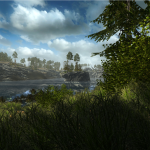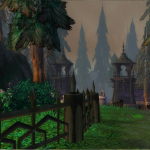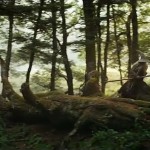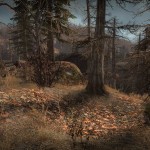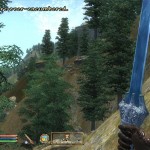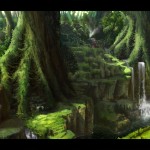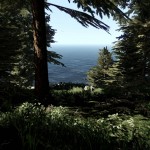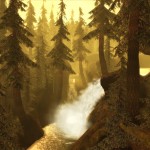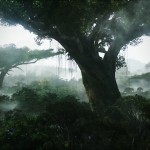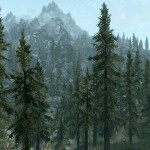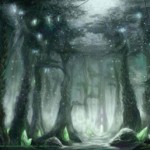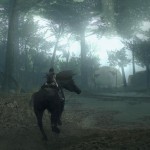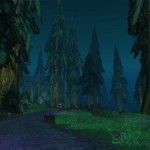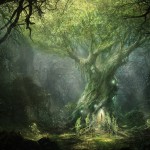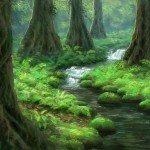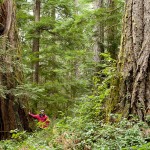|
|
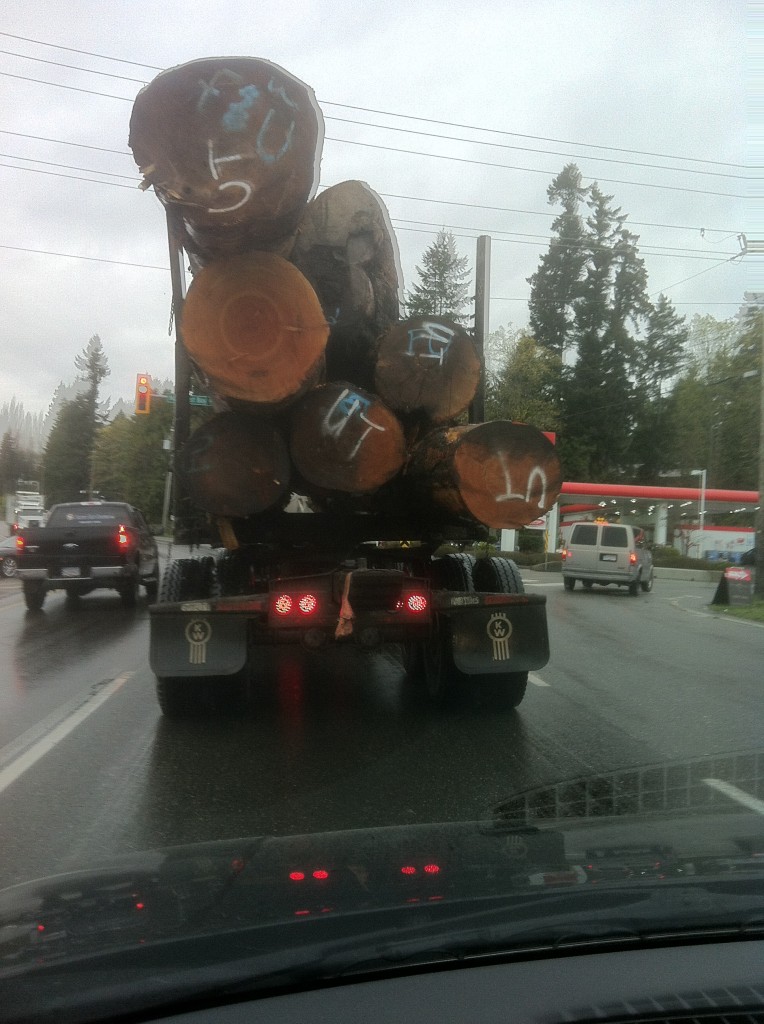 Vancouver Island highway scene At this ardently bright juncture of the year, there is something quite delightful about gazing up into the cool, rustling canopy of overhanging trees. It is a very deep memory for me. I must have been an infant, lying on the back bench seat of my parents’ old Buick, gazing up through the rear window at the dark tunnel of foliage billowing overhead, flashing here and there with orange bursts of interpenetrating sunlight. The dust from the road was starting to smell like the softer evening version of itself and the roadside insects, cicadas probably, hissed in their enormous, invisible numbers.
In my recent journeys between England and Canada, I have been struck by the contrast in attitudes toward what one might call ‘arboreal heritage’ between the two places. When driving on Vancouver Island I am inevitably torn between throwing up and crying whenever I see, as I almost always do, some of the last old growth Douglas firs (Pseudotsuga menziesii) getting hauled down the highway on some logging truck. Their rate of felling has been accelerated recently by a growth in demand from overseas, particularly Chinese, markets and the provincial government’s stupendously short-sighted decision to relax restrictions on the exporting of raw logs.
Each one of these ancient trees is a monument to the passing of centuries, a lynchpin around which complex ecological processes have evolved and yet we are losing the last primeval stands right at this very moment. To see one of those loaded trucks is like witnessing the carcass of a blue whale or a rhinoceros trucked off to a dog food factory but what more is there to be said? We have pointed our fingers yet the market economy has triumphed and the trees continue to fall. Soon all there will be left is a lingering sense of shame until that too eventually disappears. Outside a few relic specimens that happen to find themselves inside parks, the ancient fir groves of Vancouver Island will soon be obliterated. The Island Timberlands company continues to be a key player in this campaign of ecological extermination and is specifically targeting the large old trees on its vast private holdings to service an international market growing all the more lucrative as the global supply of first growth trees plummets.
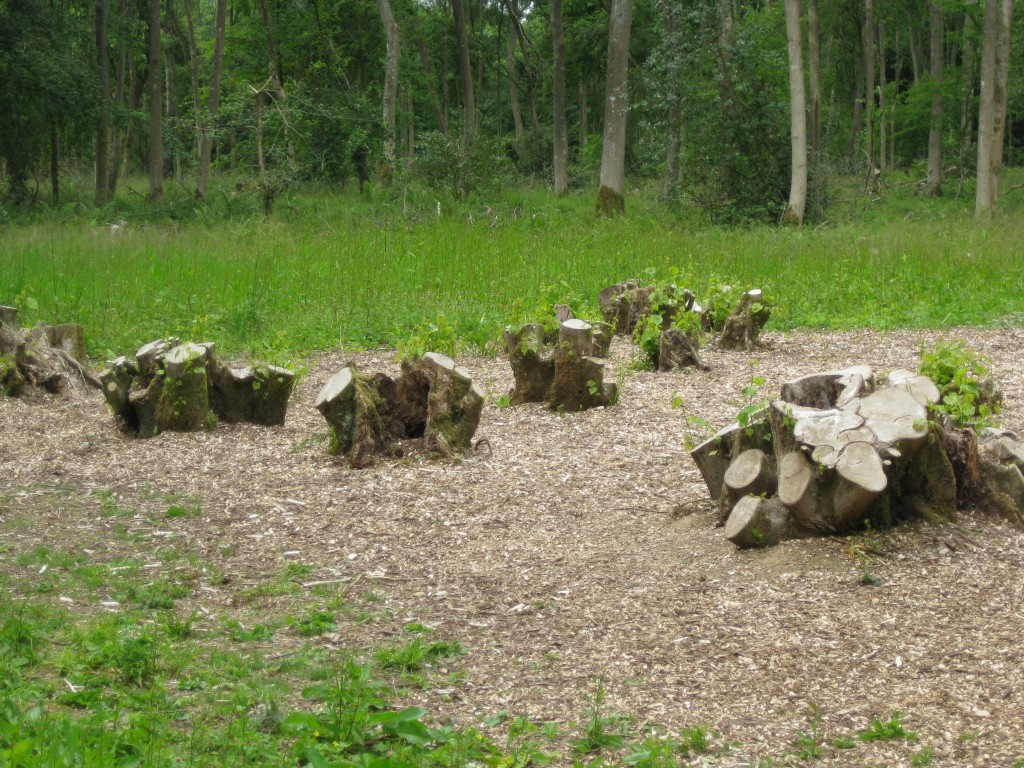 this linden (lime) tree has been coppiced since at least the 13th century! While British Columbia has been embarrassingly and heartbreakingly remiss in its protection of Vancouver Island’s ancient firs, there are pockets of silvicultural enlightenment elsewhere in the world that can restore one’s faith in humanity. Last month Ruth and I spent a memorable afternoon at the Westonbirt Arboretum and got introduced to some of its innovative programs by director Simon Toomer. It may sound odd, but one of the highlights of our tour was seeing the manifold stumps of a recently harvested lime (Tilia sp.) tree, which has been harvested using the coppicing technique since at least the 13th century. The tree itself, which has spread out into about 60 individual stems, could be over a thousand years old! Coppicing (periodic cutting from regrowth regenerated from stumps or ‘stools’) is an ancient technique, suitable for a variety of mostly broadleaf trees, which paradoxically causes them to live much longer than if they were allowed to grow uncut. The practice periodically opens up parts of the forest canopy, allowing for an influx of light and a host of species dependent on brighter conditons, which enhances diversity in the forest, without massacring the entire structure over a large landscape as is done during industrial clear cutting. In British Columbia, it would definitely be worth testing out large-scale coppice management of Big-leafed maple (Acer macrophyllum) and Red Alder (Alnus rubra), both of which are capable of rapid regeneration from stumps and which have the potential to produce a range of sustainable wood products.
Westonbirt is also engaged in pioneering research on how forests will be affected by climate change and have initiated a series of long term trials of trees, hailing from a spectrum of locations, from the southern to northern parts of their present day ranges. If conditions continue to heat up, it is likely that trees evolving in more southerly latitudes will increasingly thrive within the British landscape, while more cold-adapted ones will only do well at higher latitudes and altitudes.
Back in British Columbia, I am beginning to draw similar conclusions. Though still in its early stages, the initial results of my Cortes Island ‘Neo-Eocene’ project indicate that some tree species now native to more southerly latitudes, such as Coast Redwood (Sequoia sempervirens) and Metasequoia (Metasequoia glyptostroboides) might actually grow faster under West Coast Canadian conditions than varieties currently prescribed for re-forestation, such as Western Red cedar (Thuja plicata). The difference is likely to intensify as northern climates continue to heat up. Climate warming is already causing massive mortality in northern populations of the native yellow cypress/cedar (Cupressus nootkatensis), because spring snow cover is no longer thick enough to protect their delicate roots from late frosts.
The premise of ‘Neo-Eocene’ is that we need to examine longer, more geologic time spans for guidance on how ecosystems might deal with the rapidly unfolding effects of anthropogenic climate change. During the Eocene Thermal Maximum, some 55 million years ago, taxa such as Sequoia, Metasequoia and Gingko, which are now extremely limited in natural distribution, did in fact range far into northern latitudes; so it makes sense to experimentally reintroduce them, especially to areas where the extant forest has been compromised by industrial logging or climate-change induced die-offs. Our concept of what is considered ‘native’ needs to be rethought, and we’ll have to expand our definition to encompass organisms that have been ‘prehistorically native.’ So bring on the Giant Ground Sloths! If only we could!
Apropos of the topic of ‘Deep Time,’ I have been invited to Finland this September to participate in the Field_Notes – Deep Time residency in subarctic Kilpisjärvi Finland. Along with the Smudge Studio folks and a bunch of other amazing people, I’ll be considering how developing a more ‘geologic’ perspective might help assess our trajectory into the deep future. As the world heats up again to levels seen only in the geologic, pre-human past, how will we cope? How long will it take for a subarctic place like Kilpisjärvi to feel like Lisbon or Lagos? Will more southerly latitudes, once temperate and agriculturally productive, become thermally uninhabitable? Will climate refugees, human and non-human, flood into the formally frigid northland? How might the northern biota adapt? Or can it? Anyway, I am endlessly excited.
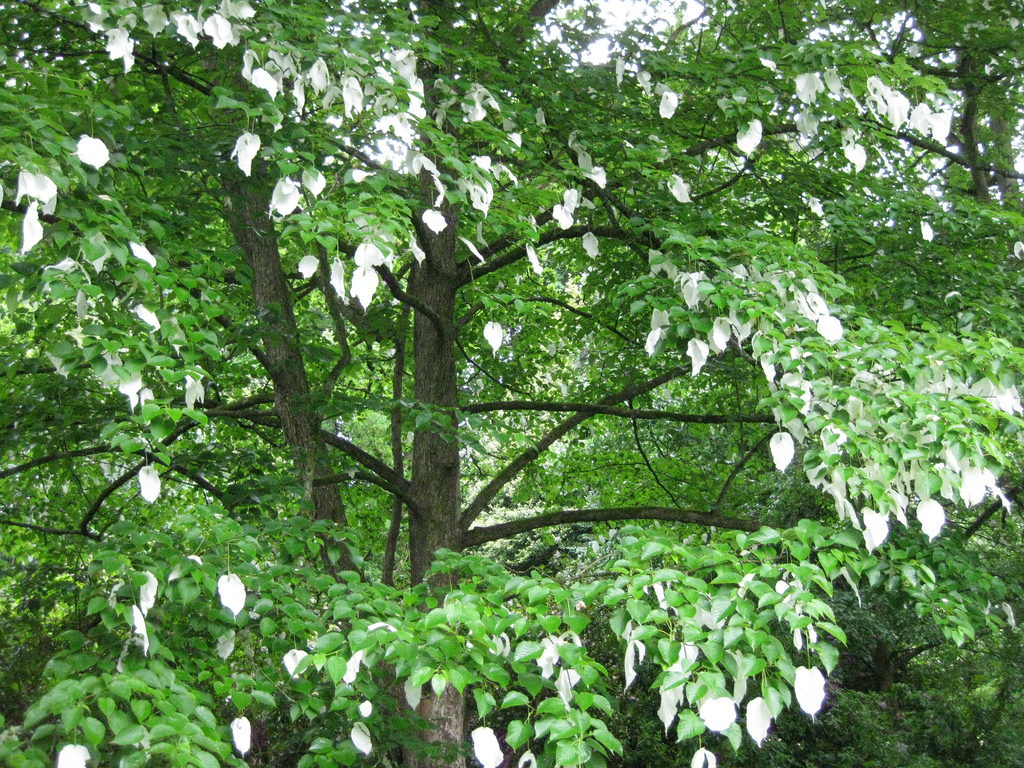 Davidia tree in Wiltshire Another refugee from deep time is the wonderfully flamboyant Davidia tree, which dates back all the way to the Miocene, when it was much more widely distributed. Miraculously, a few groves somehow survived the intervening millennia deep within the gorges of Szechuan China. The tree with its magnificent, floppy white bracts, which some liken to handkerchiefs or doves, caught the attention of a French missionary, Abbé Armand David. He sent some dried samples back to Europe and a botanical sensation promptly ensued. It wasn’t long before a plant hunters from England and the United States were dispatched to what was then a very remote area, charged with collecting Davidia seeds for cultivation. In the Davidia’s case, this proved to be a boon for the global population as there are now fine specimens of the tree flourishing in parks and gardens throughout the temperate zones of the world, thanks to those early batches of seed. Davidia, as is the case with Metasequoia and Gingko are considered vulnerable in their native habitat, and it is only through their widespread cultivation outside the small territories in which they still naturally occur that their future remains assured. Yet who knows? These curious and obscure trees might contain within them a genetic willingness to reestablish themselves in vast swathes of the northern hemisphere, as the climate of the distant geologic past becomes the climate of the not so distant future. Here is a picture of the biggest Davidia I have ever seen. It was in full, glorious bloom, when I visited the the grounds of a lovely Wiltshire property, owned by the Guinness family. Judging by its size, this specimen seems likely to have been one of the first ones propagated – an ambassador of sorts from the distant geologic past that once again has a role to play in the beauty of the wider world.
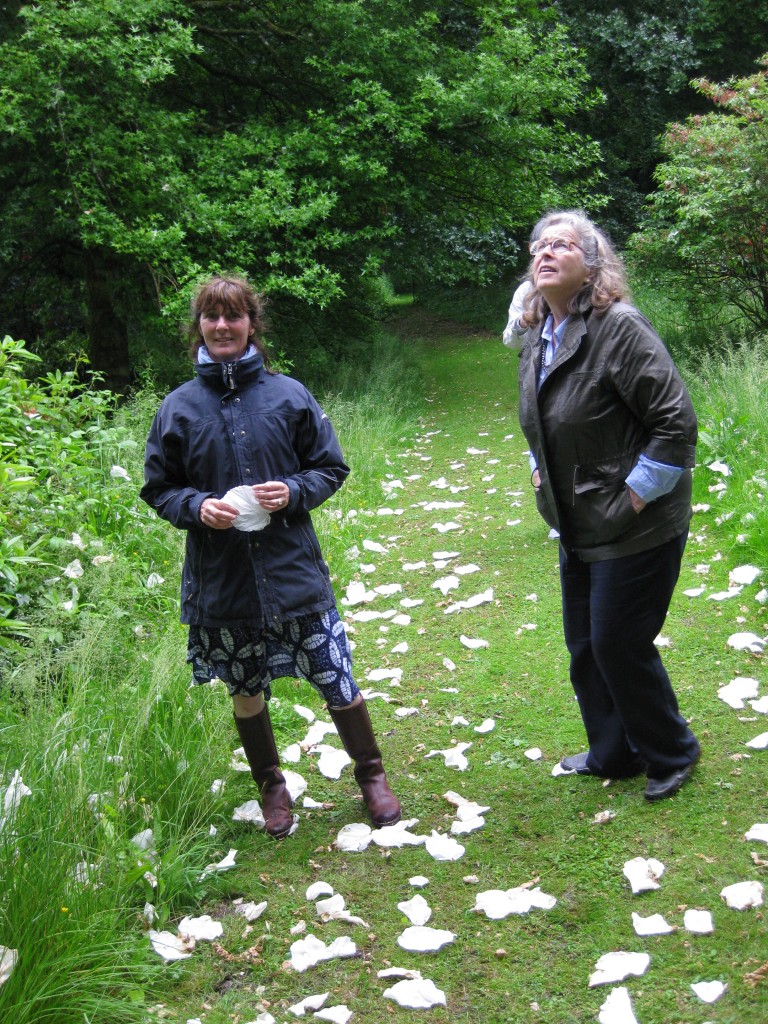 a flurry of doves or handkerchiefs!
The old growth forests of Vancouver Island are almost gone. The overwhelming majority have already been cut down and in many cases what has grown back has been whacked back several times over, leaving us with a landscape which, while wooded and at times even beautiful, is basically a ravaged, stunted version of something that was once truly glorious.
On Cortes Island, British Columbia where I live, the forest is an unusual ‘dry rainforest’ known as the (the very dry eastern variant of the Coastal Hemlock zone), which has less than 1% its original forest cover remaining. Some of the finer groves are about to be razed, put on container ships and shipped overseas by a company called Island Timberlands, itself set to be partially bought out by the $480 billion China Investment Corporation (CIC). Under the rules of globalized, neo-liberal economics this is all perfectly legal and in fact encouraged by a compliant provincial government who have been major recipients of forest industry campaign donations during the last election. To reward their benefactors, the BC government further gutted the already weak legislation governing the protection of the environment on private forest lands to the point where it has essentially been left to regulate itself.
The destruction of Cortes’ forests might have started any day now, were it not for outraged citizens physically putting themselves on the line to prevent Island Timberlands from starting its logging operations. This is truly a last ditch effort, noble but doomed to failure unless someone in political power steps up to the plate and comes up with a way of saving this piece of a vanishing ecological heritage.
Yet in a bizarre mirroring effect, as the real world’s ancient forests disappear before our eyes, they proliferate like never before in the simulacrum world of video games and fantasy films. From The Hobbit to World of Warcraft the old growth archetype lives on as a majestic and mysterious backdrop for the exploits of our avatars and fictional heroes. We are drawn to the these places in our imagination, yet can’t prevent ourselves from destroying the last examples of the real thing. Perhaps we will come to prefer them pixellated. Perhaps we already do.
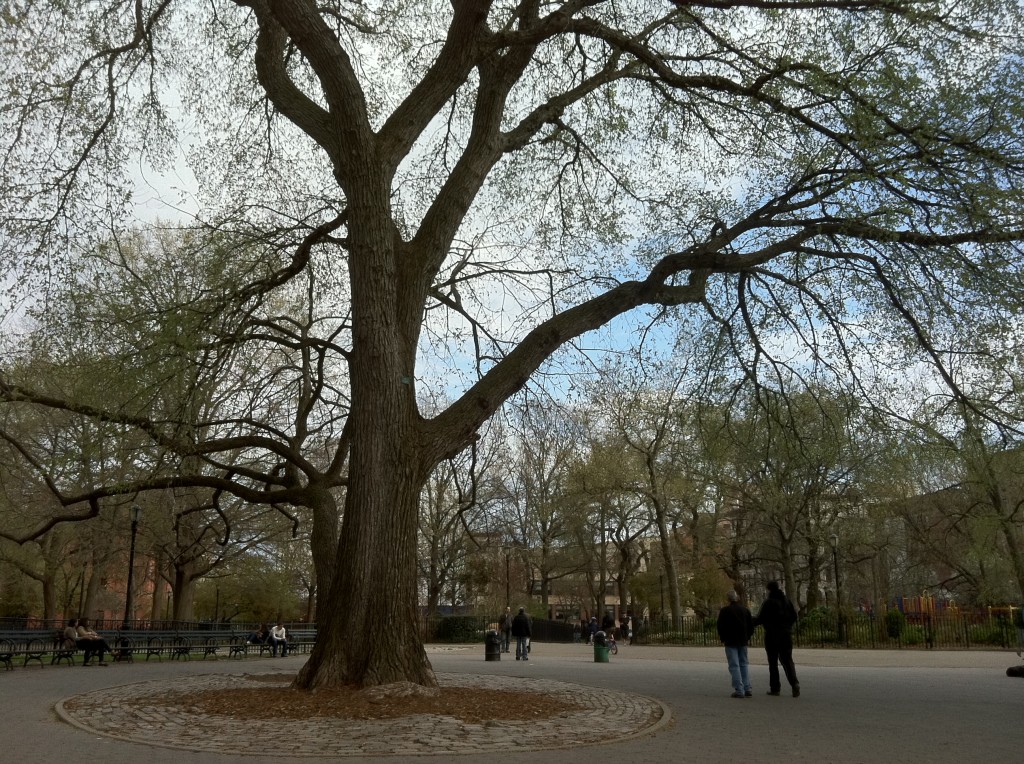 Tompkins Square's American Elms
The hot breath of a globally-warmed, East Coast spring brings with it many surprises. A friend of mine, a young woman, writes to me from the surreal mid March heat of Montreal, the doors and windows of her apartment all open.
‘Is it you who once spoke of the new phenomenon of grieving natural landscapes? How about grieving a Season? Winter is a part of me. A genetic part I must say too!
Culturally, winter is at the center of so much life around here. So many memories about Winter. So long Winters. Skating on the river near my parents house when I was a kid… haven’t skated there since 1998…why? Because the ice hasn’t been thick enough to be safe to skate. Or there was just plain no ice at all. What about the ice fishing villages? What about hockey games outside? What about maple syrup…the sugar season has lost nearly a month in the past 10 years! This year it was a little more than 2 weeks. Spring won, Winter was too tired to fight back.’
Here in Manhattan, the leaves and flowers have been unfurling far, far ahead of schedule. The daffodils, usually in their prime by mid March have already come and gone in nearby Tompkins Square Park – a full month earlier than is usual. It didn’t take long for my sinuses to react to the the pollen billowing in from the park’s stately American Elm trees (Ulmus americana). These venerable giants, planted by the great Frederick Law Olmstead, still flourish in the city’s metropolitan parks long after their rural brethren have succumbed to the 20th century plague of Dutch Elm disease. On the island of Manhattan, the elms are protected by encircling rivers and a miles wide cordon sanitaire of buildings and pavement that prevents the elm bark beetle, which spreads the disease, from infecting them. It’s delightful to me that all those crushing tires and stomping feet are actually aiding conservation.
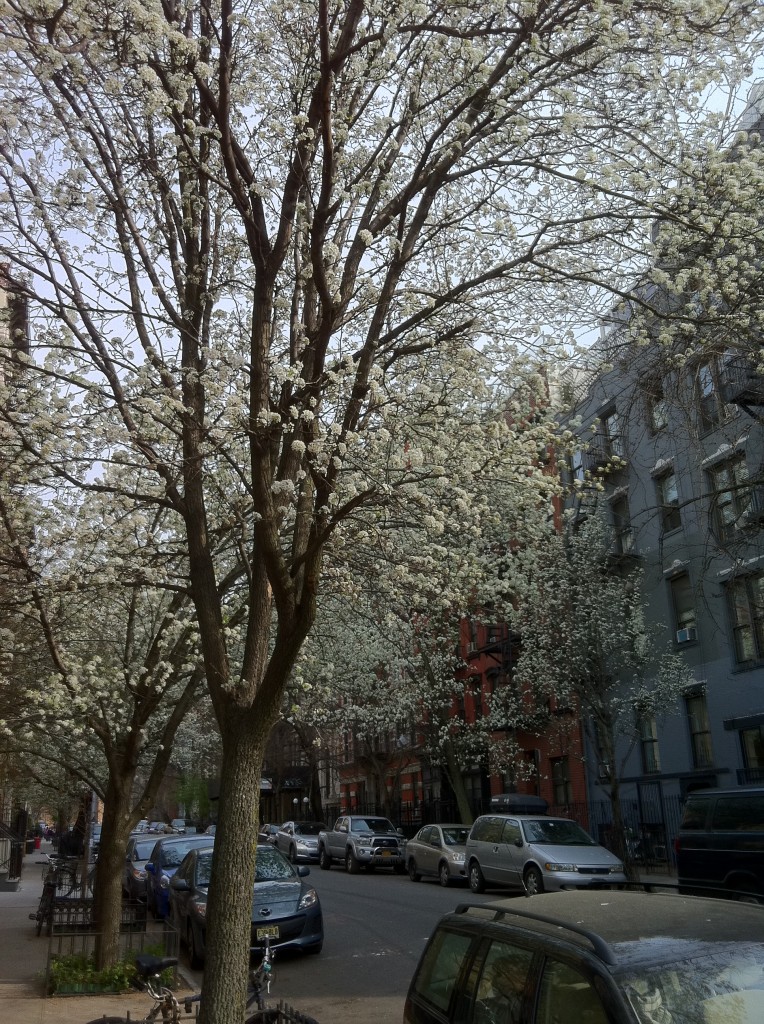 East Village spunk trees
As soon as the elm pollen fades, the cloying pong of Callery Pear (Pyrus calleryana) starts wafting through the East Village’s streets, the skeletal branches erupting into billowing, white flower clouds seemingly overnight, pushed into bloom by the strangely overheated breezes. Callery Pear is commonly known as the ‘spunk tree’ in these parts and the semen-like scent is strongest when the pollen starts going rancid after a bit of rain. The odor along St Mark’s place was particularly pungent this year, adding a whole other dimension to what some would say was an already rather skanky stretch of street. Once the trees stink themselves out, they become quite pleasant, bearing tiny Asian pears, from which my friend Marina Zurkow concocted a delicious alcoholic drink, after we foraged for the fruits on the shores of Brooklyn, last November.
A close second in the ejaculatory odor department is the Ghetto Palm, (Ailanthus altissima), which is found throughout the city’s waste places and terraines vagues. Thankfully it doesn’t flower till a fair bit later in the season!
How concerned should we be when the spring arrives so suddenly, so many weeks ahead of schedule? For someone like me, who hates extreme cold, this year’s eastern ‘non-winter’ should have seemed like a gift from the gods – a welcome break from the tedium of snow shoveling and galoshes. There have always been periods of aberrant weather – so why worry now?
The big picture on climate change is indeed concerning. Weather all over the planet has become increasingly extreme and records are being shattered left, right and center. The common denominator to all this chaos is global warming and it seems clear we are at the beginning of an epic shift. A recent study published in the New Scientist predicted an average 3 degrees C rise in global temperatures by 2050 – a scenario far worse than even the direst projections of a few years ago.
In addition to the ecological and economic effects, I wonder what will be the psychological outcomes of such aberrant weather? A certain predictability to the seasons seems necessary for our sense of well-being and if we can’t take some consistency for granted anymore, would it be any surprise if some of us go a little nuts?
Though we might be ‘grieving a season’ now, what will it be like when we forget completely what was once considered ‘normal’ and settle into a state of climate amnesia?
On a recent visit to suburban Toronto, I reminisced with my elderly parents over photos taken during my childhood. Forty years ago, we skated every winter on the ice of the nearby river. It was always thick enough to support the weight of snow clearing tractors and kiosks selling hot chocolate. Such reliably cold conditions seem almost inconceivable in that region now, a climate reality resigned to a distant past. An entire generation has grown up there since with no experience of the joys and tribulations of a reliably frigid winter. Perhaps the climate will someday settle into a newer, hotter ‘normal,’ but in the meantime it seems we’ll have to endure the instability of the current ‘abnormal,’ with plenty of unanticipated weirdness to come.
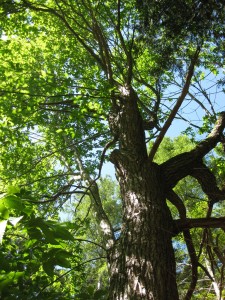 Possible American Chestnut Whaletown BC
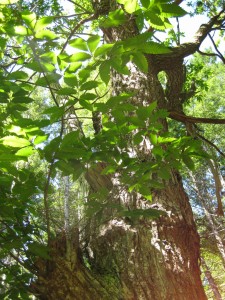 rustling late afternoon spire
One of my earliest and most cherished childhood memories is of lying back on the rear seat of my parents’ thrumming Buick, never having known the restraint of a car seat or a safety belt and gazing up through the rear window as great leafy vaults of deciduous trees passed overhead, interspersed now and then by flashes of golden, late afternoon sunshine. I remember the sharp smell of the road dust and the orange glint of an oriole, clinging to its bag-like nest, high in an overhanging bough. For me, these childhood memories of shimmering tree tunnels are the archetype of summer; languid yet ephemeral and intensely poignant; all the more so knowing as I do that the trees and the bucolic dirt roads they overshadowed were obliterated by Toronto’s urban sprawl just a few years after I first experienced them. But even before the onslaught of cul de sacs and strip malls, the landscape of my childhood was changing. As I blissfully dozed on that vast bench seat, there were elm trees all around me getting silently infected by Dutch Elm disease. Within a decade or so their massive viridian canopies stood leafless and rattling against the Ontario sky like the withered tentacles of giant squids for whom the sea had suddenly drained away.
50 years before the great dying of the elms, an even more widespread and perhaps more consequential tree extirpation was underway. This was demise of the American Chestnut (Castanea dentata), once a key component of the hardwood forest zone that stretches from southern Ontario through the Appalachians into the American South. The American chestnut, which by some accounts comprised up to 25% of these predominantly deciduous forests, was almost completely extirpated by a fungal blight, mistakenly introduced to North America via the importation of a few Chinese chestnut (Castanea mollissima) trees to the Bronx. The disease spread virulently through the highly susceptible American species and within a few decades, millions had died, changing the character of the Eastern forests forever. Yet here and there a few clung to life, protected because they grew in places somehow inaccessible to the blight’s spores or because they had quirky genetics, which rendered them partial immune to the rampant epidemic. Since the peak of the blight, these genetically endowed survivors have been sought out by plant breeders who have been crossing them with Chinese chestnuts in the hopes of developing trees that combine the lofty growth of the American tree with the disease resistance of their compact Chinese parents. Progress has been slow but steady and the successful progeny of these breeding trials have been being planted in parks and arboretums for some years now, sponsered primarily by the American and Canadian Chestnut societies.
The loss of the American Chestnut was a colossal blow not only to the biodiversity of their habitat (their nuts were a key food source for the now extinct Passenger Pigeon) but to the human food supply as well. Chestnuts are similar in food value to grains and also contain significant quantities of Vitamin C yet they don’t need the intense inputs of energy and resources demanded every year by most cereal crops. Once trees are established, the only labor is to harvest nuts once a year and perhaps thin competing trees here and there to maintain the health of the grove. J. Russell Smith describes traditional European agroforestry systems base on chestnuts in his classic (1929) Tree Crops – A Permanent Agriculture; a book he wrote in response to the contemporaneous collapse of the American agriculture system at the start of the Great Depression. Smith extols the virtues of these perennial tree-based ‘permacultures’ and recounts a level of prosperity and leisure in the nut growing areas, unthinkable to the misery inflicted grain farmers of the Dust Bowl era. In addition to the market value of the nuts themselves, Smith describes the exceptional quality and desirability of the pork fattened on nuts left behind under the trees after the harvest. In this day and age, given the amount of arable land devoted to corn, which is in turn fed to cattle and pigs, it seems to make a lot sense to switch, at least partially, to animal food sourced from such sustainable, tree-based permacultures. This would also provide added benefits such as enhanced wildlife habitat, the protection of watersheds and carbon sequestration. A recent Purdue University study showed that the American Chestnut can store up to three times more carbon than other trees sharing its ecosystem, which against the backdrop of climate change gives us another compelling reason to reestablish chestnut over large areas.
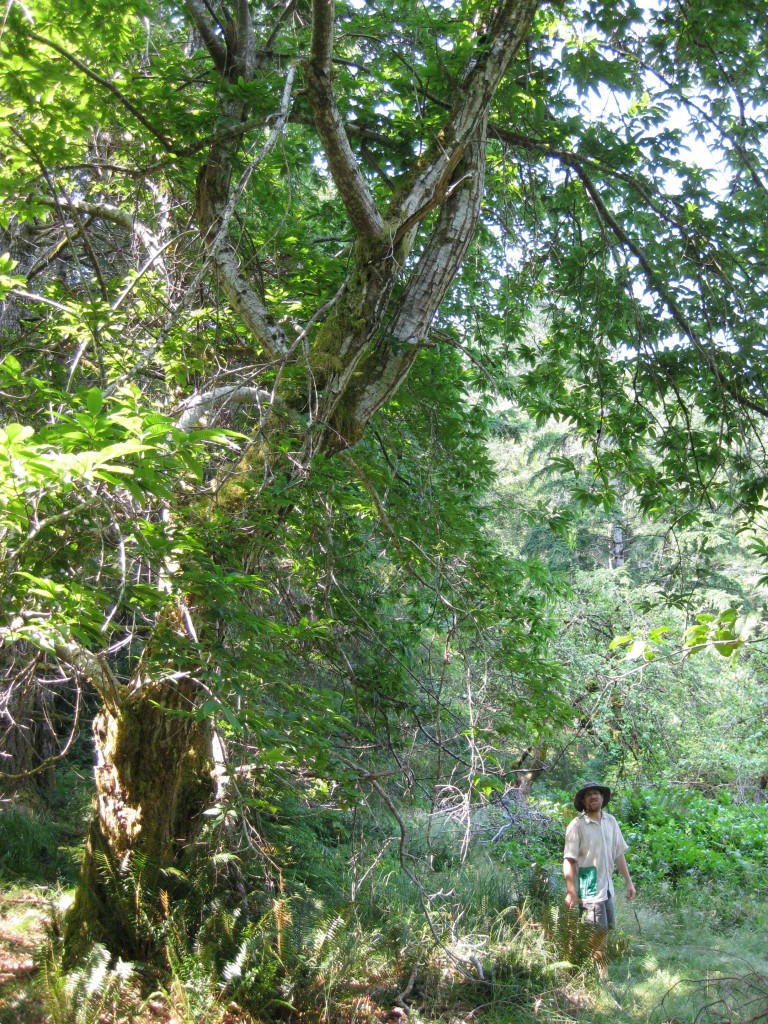 European Chestnut, Carrington Bay. Coastal British Columbia is far removed from the native range of the American Chestnut yet its European cousin (Castanea sativa) has been planted here occasionally and thrives, particularly in areas such as the Gulf Islands and the Lower Mainland, which have warmer summers. For years, I have been admiring a particularly stately tree that grows on the edge of my property in Whaletown on Cortes Island. I had always assumed it was a particularly large specimen of Castanea sativa yet there was something odd about the tree’s great height – over 60 feet. It seems to have no trouble completing for sun with the surrounding Douglas firs and Big-leaf maples and looks truly at home in its forest setting. The nuts it produces are tiny; less than 3/4 of an inch or so, which is much smaller than any commercially available eating chestnuts I have seen.
All of this made me wonder if I might all these years have been looking at an example of the elusive American chestnut – Castanea dentata. I figured the odds were pretty small, given that the European species is so prevalent in these parts but still my doubts persisted.
A couple of weeks ago, I finally got around to keying out the tree, using this helpful on-line guide (chestnut ID) put out by the Massachusetts Chapter of The American Chestnut Foundation, as well as this web site (more ID), which provides detailed photos of the leaves, twigs and nuts of all the chestnut species, for easy comparison. Surprisingly, my tree shows a lot of the characteristics of the American variety, yet I’m still not exactly certain. Chestnuts seem maddeningly difficult to identify, especially since hybridization is always a possibility.
A good portion of the older fruit trees on Cortes Island trace their provenance to a man by the name of Hayes, a former employee of the genius plant breeder Luther Burbank, who moved to these parts in the early days 20th century, so it is possible that the chestnut was one of Burbank’s (crosses). The tree seems to be about the right age, just shy of a hundred, given its substantial girth and height. The leaves of the tree are papery thin and extremely long; the longest one I measured coming in at almost 11 inches. The leaf edges are serrated by curved teeth ending in a single bristle in accordance with the descriptions for Castanea dentata. The twigs are smooth and supple, which also points to the American Chestnut. The vast majority of the nuts when they drop from the tree, shrivel, un-pollinated inside their sea urchin-like casings, but every year a few of them germinate in the leaf litter until, inevitably, they get browsed down by hungry deer. This year though, I have 5 or 6 of the seedlings in pots and I plan to grow more in the hopes of getting a grove going and to be able to distribute the seedlings to other nut enthusiasts. It’d be great to see whole forests of these magnificent trees get established, in blight-free areas of the West Coast, especially on large tracts of logged over land, ravaged by the forest industry.
I’ve attached a link to a Flickr photo set of the whole tree, the nut casings and the leaves as well as the leaves of another chestnut variety I purchased around ten years ago as C. sativa, for the purposes of comparison. If anyone can help me identify this magnificent tree, I would be most appreciative. Please do so via the comment feature of this blog and I’ll get right back to you. Thanks so much!
|
|






